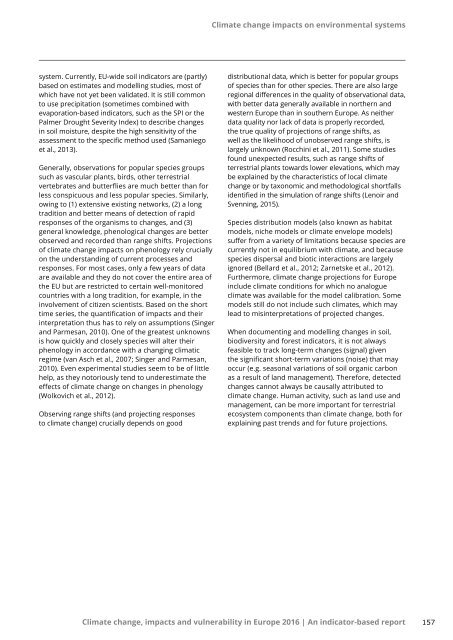Climate change impacts and vulnerability in Europe 2016
document
document
Create successful ePaper yourself
Turn your PDF publications into a flip-book with our unique Google optimized e-Paper software.
<strong>Climate</strong> <strong>change</strong> <strong>impacts</strong> on environmental systems<br />
system. Currently, EU-wide soil <strong>in</strong>dicators are (partly)<br />
based on estimates <strong>and</strong> modell<strong>in</strong>g studies, most of<br />
which have not yet been validated. It is still common<br />
to use precipitation (sometimes comb<strong>in</strong>ed with<br />
evaporation-based <strong>in</strong>dicators, such as the SPI or the<br />
Palmer Drought Severity Index) to describe <strong>change</strong>s<br />
<strong>in</strong> soil moisture, despite the high sensitivity of the<br />
assessment to the specific method used (Samaniego<br />
et al., 2013).<br />
Generally, observations for popular species groups<br />
such as vascular plants, birds, other terrestrial<br />
vertebrates <strong>and</strong> butterflies are much better than for<br />
less conspicuous <strong>and</strong> less popular species. Similarly,<br />
ow<strong>in</strong>g to (1) extensive exist<strong>in</strong>g networks, (2) a long<br />
tradition <strong>and</strong> better means of detection of rapid<br />
responses of the organisms to <strong>change</strong>s, <strong>and</strong> (3)<br />
general knowledge, phenological <strong>change</strong>s are better<br />
observed <strong>and</strong> recorded than range shifts. Projections<br />
of climate <strong>change</strong> <strong>impacts</strong> on phenology rely crucially<br />
on the underst<strong>and</strong><strong>in</strong>g of current processes <strong>and</strong><br />
responses. For most cases, only a few years of data<br />
are available <strong>and</strong> they do not cover the entire area of<br />
the EU but are restricted to certa<strong>in</strong> well-monitored<br />
countries with a long tradition, for example, <strong>in</strong> the<br />
<strong>in</strong>volvement of citizen scientists. Based on the short<br />
time series, the quantification of <strong>impacts</strong> <strong>and</strong> their<br />
<strong>in</strong>terpretation thus has to rely on assumptions (S<strong>in</strong>ger<br />
<strong>and</strong> Parmesan, 2010). One of the greatest unknowns<br />
is how quickly <strong>and</strong> closely species will alter their<br />
phenology <strong>in</strong> accordance with a chang<strong>in</strong>g climatic<br />
regime (van Asch et al., 2007; S<strong>in</strong>ger <strong>and</strong> Parmesan,<br />
2010). Even experimental studies seem to be of little<br />
help, as they notoriously tend to underestimate the<br />
effects of climate <strong>change</strong> on <strong>change</strong>s <strong>in</strong> phenology<br />
(Wolkovich et al., 2012).<br />
Observ<strong>in</strong>g range shifts (<strong>and</strong> project<strong>in</strong>g responses<br />
to climate <strong>change</strong>) crucially depends on good<br />
distributional data, which is better for popular groups<br />
of species than for other species. There are also large<br />
regional differences <strong>in</strong> the quality of observational data,<br />
with better data generally available <strong>in</strong> northern <strong>and</strong><br />
western <strong>Europe</strong> than <strong>in</strong> southern <strong>Europe</strong>. As neither<br />
data quality nor lack of data is properly recorded,<br />
the true quality of projections of range shifts, as<br />
well as the likelihood of unobserved range shifts, is<br />
largely unknown (Rocch<strong>in</strong>i et al., 2011). Some studies<br />
found unexpected results, such as range shifts of<br />
terrestrial plants towards lower elevations, which may<br />
be expla<strong>in</strong>ed by the characteristics of local climate<br />
<strong>change</strong> or by taxonomic <strong>and</strong> methodological shortfalls<br />
identified <strong>in</strong> the simulation of range shifts (Lenoir <strong>and</strong><br />
Svenn<strong>in</strong>g, 2015).<br />
Species distribution models (also known as habitat<br />
models, niche models or climate envelope models)<br />
suffer from a variety of limitations because species are<br />
currently not <strong>in</strong> equilibrium with climate, <strong>and</strong> because<br />
species dispersal <strong>and</strong> biotic <strong>in</strong>teractions are largely<br />
ignored (Bellard et al., 2012; Zarnetske et al., 2012).<br />
Furthermore, climate <strong>change</strong> projections for <strong>Europe</strong><br />
<strong>in</strong>clude climate conditions for which no analogue<br />
climate was available for the model calibration. Some<br />
models still do not <strong>in</strong>clude such climates, which may<br />
lead to mis<strong>in</strong>terpretations of projected <strong>change</strong>s.<br />
When document<strong>in</strong>g <strong>and</strong> modell<strong>in</strong>g <strong>change</strong>s <strong>in</strong> soil,<br />
biodiversity <strong>and</strong> forest <strong>in</strong>dicators, it is not always<br />
feasible to track long-term <strong>change</strong>s (signal) given<br />
the significant short-term variations (noise) that may<br />
occur (e.g. seasonal variations of soil organic carbon<br />
as a result of l<strong>and</strong> management). Therefore, detected<br />
<strong>change</strong>s cannot always be causally attributed to<br />
climate <strong>change</strong>. Human activity, such as l<strong>and</strong> use <strong>and</strong><br />
management, can be more important for terrestrial<br />
ecosystem components than climate <strong>change</strong>, both for<br />
expla<strong>in</strong><strong>in</strong>g past trends <strong>and</strong> for future projections.<br />
<strong>Climate</strong> <strong>change</strong>, <strong>impacts</strong> <strong>and</strong> <strong>vulnerability</strong> <strong>in</strong> <strong>Europe</strong> <strong>2016</strong> | An <strong>in</strong>dicator-based report<br />
157


